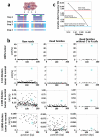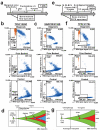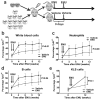Role of TP53 mutations in the origin and evolution of therapy-related acute myeloid leukaemia
- PMID: 25487151
- PMCID: PMC4403236
- DOI: 10.1038/nature13968
Role of TP53 mutations in the origin and evolution of therapy-related acute myeloid leukaemia
Abstract
Therapy-related acute myeloid leukaemia (t-AML) and therapy-related myelodysplastic syndrome (t-MDS) are well-recognized complications of cytotoxic chemotherapy and/or radiotherapy. There are several features that distinguish t-AML from de novo AML, including a higher incidence of TP53 mutations, abnormalities of chromosomes 5 or 7, complex cytogenetics and a reduced response to chemotherapy. However, it is not clear how prior exposure to cytotoxic therapy influences leukaemogenesis. In particular, the mechanism by which TP53 mutations are selectively enriched in t-AML/t-MDS is unknown. Here, by sequencing the genomes of 22 patients with t-AML, we show that the total number of somatic single-nucleotide variants and the percentage of chemotherapy-related transversions are similar in t-AML and de novo AML, indicating that previous chemotherapy does not induce genome-wide DNA damage. We identified four cases of t-AML/t-MDS in which the exact TP53 mutation found at diagnosis was also present at low frequencies (0.003-0.7%) in mobilized blood leukocytes or bone marrow 3-6 years before the development of t-AML/t-MDS, including two cases in which the relevant TP53 mutation was detected before any chemotherapy. Moreover, functional TP53 mutations were identified in small populations of peripheral blood cells of healthy chemotherapy-naive elderly individuals. Finally, in mouse bone marrow chimaeras containing both wild-type and Tp53(+/-) haematopoietic stem/progenitor cells (HSPCs), the Tp53(+/-) HSPCs preferentially expanded after exposure to chemotherapy. These data suggest that cytotoxic therapy does not directly induce TP53 mutations. Rather, they support a model in which rare HSPCs carrying age-related TP53 mutations are resistant to chemotherapy and expand preferentially after treatment. The early acquisition of TP53 mutations in the founding HSPC clone probably contributes to the frequent cytogenetic abnormalities and poor responses to chemotherapy that are typical of patients with t-AML/t-MDS.
Figures










Comment in
-
Leukaemia: exploring origins and evolution.Nat Rev Cancer. 2015 Feb;15(2):68. doi: 10.1038/nrc3897. Epub 2015 Jan 8. Nat Rev Cancer. 2015. PMID: 25567582 No abstract available.
References
-
- Christiansen DH, Andersen MK, Pedersen-Bjergaard J. Mutations with loss of heterozygosity of p53 are common in therapy-related myelodysplasia and acute myeloid leukemia after exposure to alkylating agents and significantly associated with deletion or loss of 5q, a complex karyotype, and a poor prognosis. J Clin Oncol. 2001;19:1405–1413. - PubMed
-
- Kayser S, et al. The impact of therapy-related acute myeloid leukemia (AML) on outcome in 2853 adult patients with newly diagnosed AML. Blood. 2011;117:2137–2145. - PubMed
Publication types
MeSH terms
Substances
Associated data
Grants and funding
LinkOut - more resources
Full Text Sources
Other Literature Sources
Medical
Molecular Biology Databases
Research Materials
Miscellaneous

